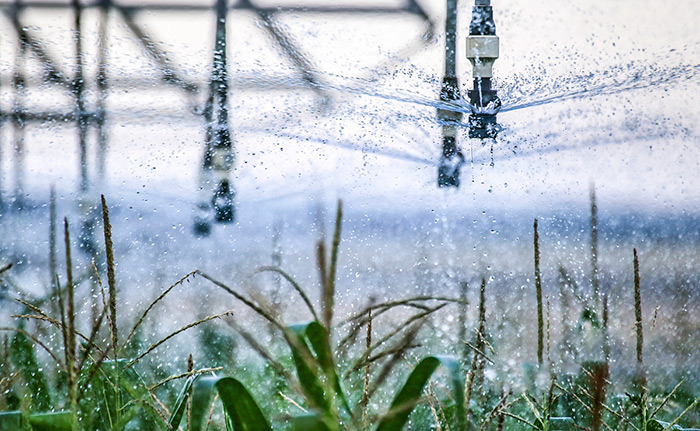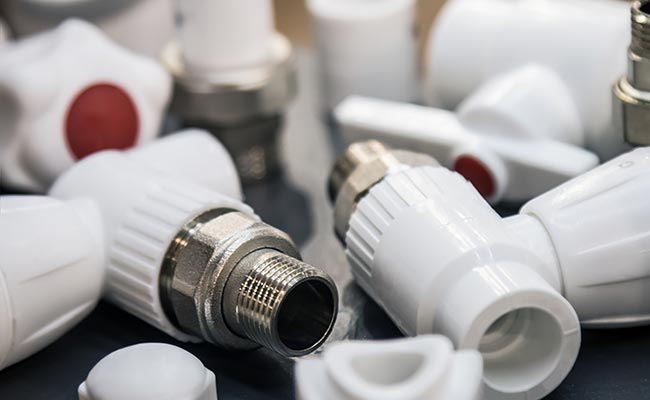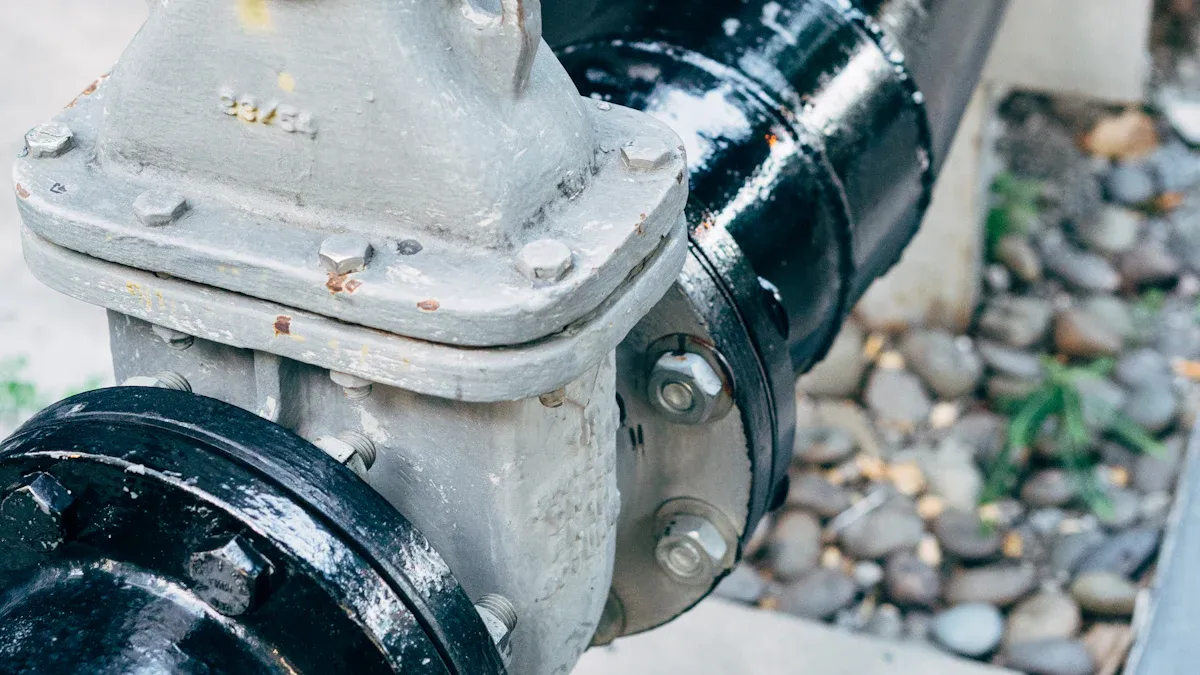
Заглушка HDPEадыгрывае жыццёва важную ролю ў сантэхніцы. Ён надзейна злучае трубы, забяспечваючы эфектыўны паток вады без уцечак. Яго трываласць робіць яго ідэальным для дамоў і прамысловых прадпрыемстваў. Незалежна ад таго, ці гэта сістэма водазабеспячэння, ці дрэнажная ўстаноўка, гэты фітынг надзейна спраўляецца з задачай. Нядзіўна, што сантэхнікі давяраюць яму складаныя праекты.
Асноўныя высновы
- Фітынгі з HDPE з заглушкамі забяспечваюць трывалыя і герметычныя злучэнні для сантэхнікі.
- Яны лёгкія і маюць расклёшаныя канцы, што спрашчае ўстаноўку.
- Гэтыя фітынгі ўстойлівыя да іржы і хімічных рэчываў, доўга захоўваючы форму ў складаных месцах.
Што такое HDPE з заглушкай і яго асноўныя характарыстыкі?
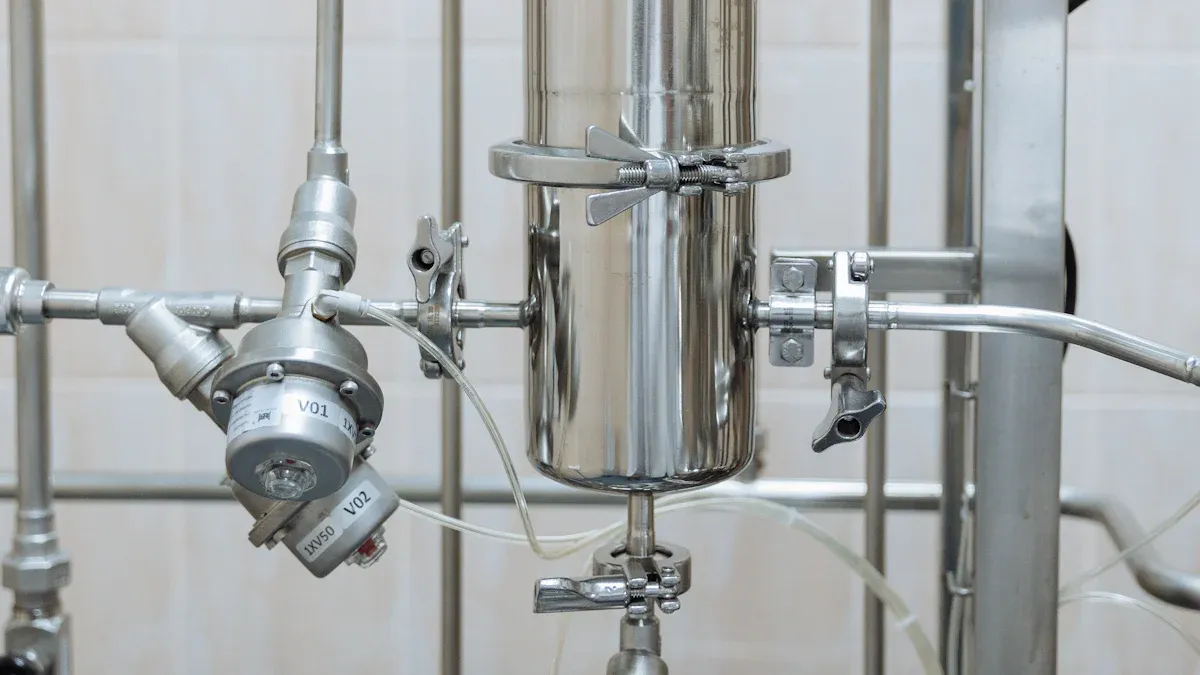
Вызначэнне і прызначэнне канцавога HDPE
Фітынг з HDPE з заглушкай — гэта спецыялізаваны фітынг для труб, прызначаны для спрашчэння сантэхнічных злучэнняў. Ён працуе разам з фланцамі для нахлеста, ствараючы надзейныя і раз'ёмныя злучэнні ў трубаправодных сістэмах. Гэты фітынг мае кароткі сегмент трубы з адным расклёшаным канцом. Расклёшаная канструкцыя дазваляе лёгка разбіраць яго, не пашкоджваючы звараныя часткі трубы. Гэта робіць яго ідэальным выбарам для сістэм, якія патрабуюць частага тэхнічнага абслугоўвання або мадыфікацыі.
Фітынг з HDPE з заглушкай асабліва карысны ў прымяненні пад высокім ціскам. Яго канструкцыя гарантуе, што злучэнне застаецца трывалым і герметычным нават у складаных умовах. Няхай гэта будзе сантэхніка ў жылых дамах ці прамысловых трубаправодах, гэты фітынг адыгрывае вырашальную ролю ў падтрыманні эфектыўнасці і надзейнасці.
Асаблівасці канструкцыі і ўласцівасці матэрыялаў
Канструкцыя HDPE для канцавых труб практычная і трывалая. Яна мае расклёшаны канец, што паляпшае яе сумяшчальнасць з фланцамі, якія злучаюцца ўнахлест. Гэтая асаблівасць не толькі спрашчае мантаж, але і забяспечвае герметычнае ўшчыльненне. Матэрыялам, які выкарыстоўваецца ў HDPE для канцавых труб, з'яўляецца поліэтылен высокай шчыльнасці (HDPE), вядомы сваім выдатным суадносінамі трываласці і вагі.
HDPE мае шэраг пераваг, у тым ліку ўстойлівасць да карозіі, хімічных рэчываў і ультрафіялетавага выпраменьвання. Гэтыя ўласцівасці робяць яго ідэальным для сантэхнічных сістэм, якія падвяргаюцца ўздзеянню суровых навакольнага асяроддзя. Для пацверджання яго надзейнасці былі праведзены выпрабаванні на сціск HDPE для тарцовых канструкцый. Гэтыя выпрабаванні пацвярджаюць яго здольнасць вытрымліваць значны ціск без шкоды для яго структурнай цэласнасці.
| Асаблівасць | Выгада |
|---|---|
| Дызайн з расклёшаным канцом | Спрашчае ўстаноўку і забяспечвае бяспечнае злучэнне |
| Паліэтылен высокай шчыльнасці | Забяспечвае трываласць, устойлівасць да карозіі і лёгкую канструкцыю |
| Магутнасць сціску | Забяспечвае надзейнасць у сітуацыях высокага ціску і лакальнага выгібу |
Даўгавечнасць і надзейнасць сантэхнічных сістэм
Канцавыя трубы з HDPE вылучаюцца сваёй трываласцю. Канструкцыя з HDPE ўстойлівая да зносу, што забяспечвае працяглы тэрмін службы. У адрозненне ад металічных фітынгаў, яны не іржавеюць і не каразіруюць, нават пры ўздзеянні вады або хімічных рэчываў. Гэта робіць іх надзейным выбарам як для жылых, так і для прамысловых сантэхнічных сістэм.
Яго надзейнасць распаўсюджваецца і на працу пад ціскам. HDPE з заглушкай забяспечвае герметычнасць, прадухіляючы ўцечкі і забяспечваючы эфектыўны паток вады. Гэтая надзейнасць памяншае неабходнасць частых рамонтаў, эканомячы час і грошы ў доўгатэрміновай перспектыве. Для сантэхнікаў і інжынераў гэта фітынг, якому яны могуць давяраць, бо ён гарантуе стабільныя вынікі.
Тыпы і перавагі заглушак HDPE
Кароткія канцы супраць доўгіх канцы
Фітынгі з HDPE з кароткімі канцамі бываюць двух асноўных тыпаў: кароткія канцы і доўгія канцы. Кожны тып служыць для пэўных мэт у залежнасці ад канструкцыі і патрэб прымянення. Кароткія канцы, таксама вядомыя як канцы MSS, кампактныя і ідэальна падыходзяць для цесных прастор. Яны добра працуюць у сістэмах з больш нізкімі патрабаваннямі да ціску і тэмпературы. З іншага боку, доўгія канцы, якія часта называюць канцамі ASA або ANSI, маюць большую даўжыню. Такая канструкцыя спрыяе больш плыўнаму патоку вадкасці і памяншае турбулентнасць, што робіць іх ідэальнымі для сістэм высокага ціску і высокай тэмпературы.
Вось кароткае параўнанне:
| Асаблівасць | Кароткія канцы шаблону (MSS) | Доўгія канцы шаблону (ASA/ANSI) |
|---|---|---|
| Дызайн | Кампактны, падыходзіць для цесных прастор. | Большая даўжыня для больш плаўнага пераходу патоку. |
| Прыкладанні | Найлепш падыходзіць для сістэм з абмежаванай прасторай. | Выдатна падыходзіць для сістэм высокага ціску і высокай тэмпературы. |
| Сумяшчальнасць | Працуе з накладнымі і нахлесточнымі фланцамі ў сістэмах нізкага ціску. | Выкарыстоўваецца з фланцамі ўнахлёст для атрымання пераваг зварных фланцаў з шыйкай. |
| Дынаміка вадкасцей | Можа выклікаць невялікую турбулентнасць. | Спрыяе лепшаму патоку з мінімальнай турбулентнасцю. |
| Тэхнічнае абслугоўванне | Лягчэйшы доступ у абмежаваных месцах. | Забяспечвае гнуткасць у абслугоўванні, адначасова забяспечваючы лепшы паток. |
Перавагі выкарыстання заглушак HDPE ў сантэхніцы
Фітынгі з HDPE з закругленымі канцамі маюць некалькі пераваг, якія робяць іх папулярным выбарам для сантэхнікі. Па-першае, яны лёгкія, але трывалыя дзякуючы канструкцыі з поліэтылену высокай шчыльнасці. Гэты матэрыял устойлівы да карозіі, хімічных рэчываў і ультрафіялетавага выпраменьвання, што забяспечвае працяглы тэрмін службы. Па-другое, іх канструкцыя з расшыранымі канцамі спрашчае ўстаноўку і дазваляе лёгка разбіраць падчас тэхнічнага абслугоўвання.
Яшчэ адна перавага — іх універсальнасць. Гэтыя фітынгі падыходзяць для шырокага спектру прымянення, ад сістэм водазабеспячэння жылых да прамысловых трубаправодаў. Яны таксама падтрымліваюць герметычнасць пад ціскам, зніжаючы рызыку ўцечак. Такая надзейнасць эканоміць час і грошы, мінімізуючы рамонт і прастоі.
Агульныя стандарты і спецыфікацыі
Фітынгі з HDPE з тарцамі павінны адпавядаць пэўным стандартам для забеспячэння якасці і прадукцыйнасці. Адным з такіх стандартаў з'яўляецца IAPMO IGC 407-2024. Гэты сертыфікат вызначае патрабаванні да матэрыялаў, фізічных характарыстык, выпрабаванняў на прадукцыйнасць і маркіроўкі. Выкананне гэтых стандартаў гарантуе надзейную працу фітынгаў у розных сантэхнічных сістэмах.
| Стандартны код | Апісанне |
|---|---|
| IAPMO IGC 407-2024 | Ахоплівае адводныя фітынгі з рознымі канцавымі злучэннямі, з указаннем патрабаванняў да матэрыялаў, фізічных характарыстык, выпрабаванняў эксплуатацыйных характарыстык і маркіроўкі. |
Адпавядаючы гэтым стандартам, фітынгі з HDPE з заглушкамі забяспечваюць спакой сантэхнікам і інжынерам, ведаючы, што яны выкарыстоўваюць сертыфікаваныя, высакаякасныя кампаненты.
Прымяненне канцавых труб HDPE ў сантэхніцы
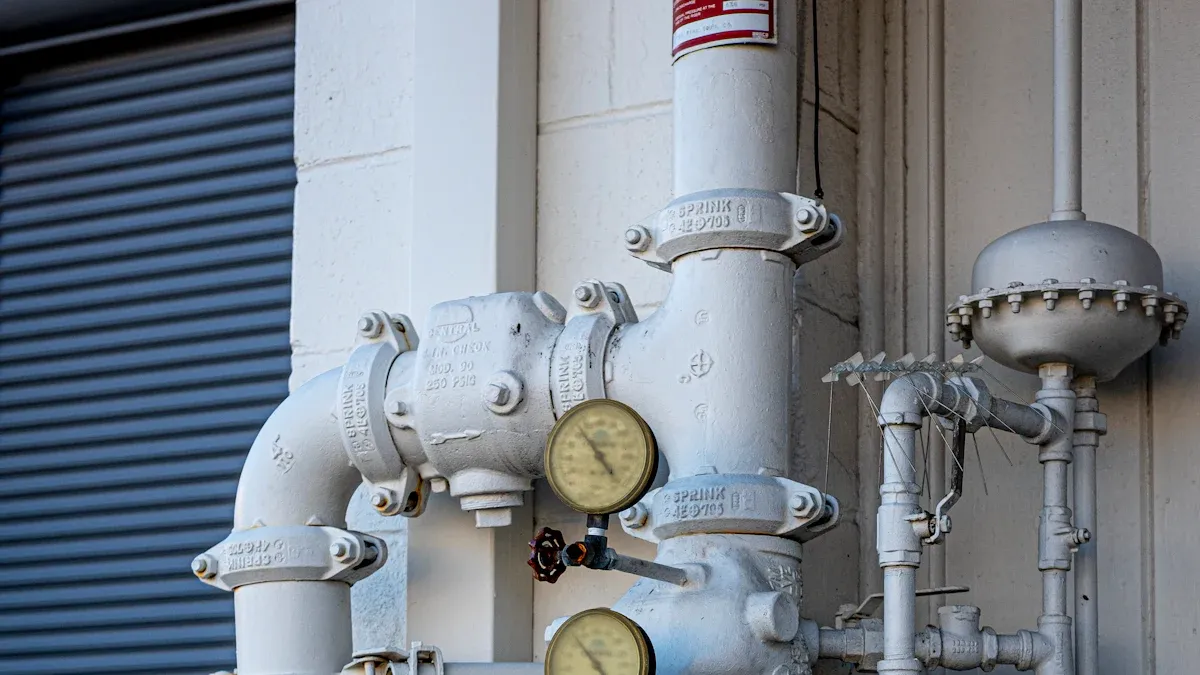
Выкарыстанне ў сістэмах водазабеспячэння і размеркавання вады
Фітынгі з HDPE з тарцамі — гэта рэвалюцыя ў сістэмах водазабеспячэння. Яны ствараюць трывалыя, герметычныя злучэнні, якія забяспечваюць бесперабойны паток вады. Гэтыя фітынгі добра падыходзяць як для жылых, так і для камерцыйных памяшканняў. Іх лёгкая канструкцыя дазваляе лёгка ўсталёўваць іх нават у цесных прасторах.
Сістэмы водазабеспячэння часта сутыкаюцца з такімі праблемамі, як перапады ціску і ўздзеянне хімічных рэчываў. Фітынгі з HDPE лёгка спраўляецца з гэтымі праблемамі. Паліэтылен высокай шчыльнасці ўстойлівы да карозіі і хімічных пашкоджанняў, забяспечваючы доўгатэрміновую надзейнасць. Сантэхнікі часта выбіраюць гэтыя фітынгі для гарадскіх вадаправодаў, таму што яны могуць вытрымліваць высокі ціск без расколін і ўцечак.
Парада:Пры ўсталёўцы канцавых адтулін з HDPE ў водазабеспячальных сістэмах неабходна забяспечыць належнае выраўноўванне з фланцамі, каб забяспечыць герметычнасць і прадухіліць уцечкі.
Роля ў сістэмах дрэнажу і сцёкавых вод
Дрэнажным сістэмам патрэбныя трывалыя фітынгі, якія могуць вытрымліваць пастаяннае ўздзеянне сцёкавых вод. HDPE з заглушкамі ідэальна падыходзіць для гэтага. Яго каразійна-ўстойлівыя ўласцівасці робяць яго ідэальным для перамяшчэння сцёкавых вод, якія часта ўтрымліваюць агрэсіўныя хімічныя рэчывы і смецце.
Гэтыя фітынгі таксама выдатна падыходзяць для падземных дрэнажных сістэм. Іх здольнасць супрацьстаяць ціску грунту і ўздзеянню навакольнага асяроддзя гарантуе, што яны застануцца непашкоджанымі на працягу многіх гадоў. Інжынеры часта выкарыстоўваюць HDPE з заглушкамі ў сістэмах кіравання ліўневымі водамі, таму што ён можа апрацоўваць вялікія аб'ёмы вады без шкоды для прадукцыйнасці.
- Асноўныя перавагі дрэнажных сістэм:
- Супраціўляе хімічнай карозіі ад сцёкавых вод.
- Спраўляецца з высокай хуткасцю патоку без уцечак.
- Добра працуе ў падземных установках.
Прымяненне ў прамысловых і высокацісных трубаправодах
Прамысловыя трубаправоды патрабуюць фітынгаў, якія могуць вытрымліваць экстрэмальныя ўмовы. Фітынгі з HDPE з тарцом адпавядаюць гэтай патрэбе. Трывалая канструкцыя і ўласцівасці матэрыялу робяць іх прыдатнымі для транспарціроўкі хімічных рэчываў, нафты і газаў. Гэтыя фітынгі захоўваюць сваю цэласнасць пад высокім ціскам, што робіць іх надзейным выбарам для фабрык і перапрацоўчых прадпрыемстваў.
У трубаправодах высокага ціску фітынгі з HDPE з канцамі мінімізуюць турбулентнасць і забяспечваюць плаўны паток вадкасці. Гэта памяншае знос сістэмы, падаўжаючы тэрмін яе службы. Прамысловасць часта аддае перавагу гэтым фітынгам, таму што яны эканамічна эфектыўныя і патрабуюць мінімальнага абслугоўвання.
| Прыкладанне | Чаму працуе HDPE з заглушкай |
|---|---|
| Хімічныя перавозкі | Супраціўляецца хімічным рэакцыям і захоўвае структурную цэласнасць. |
| Нафтагазаправоды | Вытрымлівае высокі ціск і прадухіляе ўцечкі. |
| Фабрычныя сістэмы | Лёгкі, але трывалы, што скарачае час мантажу. |
Заўвага:Рэгулярныя праверкі прамысловых трубаправодаў з выкарыстаннем HDPE-канцавых трубаправодаў могуць дапамагчы выявіць знос на ранняй стадыі і прадухіліць дарагі рамонт.
Усталёўка і сумяшчальнасць канцавых адтулін HDPE
Этапы ўстаноўкі фітынгаў з HDPE з заглушкамі
Усталёўка фітынгаў з HDPE з тарцамі нескладаная, калі выконваць правільныя дзеянні. Спачатку пераканайцеся, што канцы труб чыстыя і без смецця. Бруд або рэшткі могуць аслабіць злучэнне. Затым выраўнуйце канцы труб з дапамогай трубарэза або абрэзчыка. Гэты крок забяспечвае належную пасадку і ўмацоўвае зварачнае злучэнне.
Пасля падрыхтоўкі трубы выраўнуйце танец HDPE з фланцам. Выкарыстоўвайце хамуты, каб зафіксаваць трубу на патрэбнай вышыні. Затым надзейна злучыце дэталі з дапамогай тэрмічнай зваркі. Дайце злучэнню цалкам астыць, перш чым пераходзіць да наступнай секцыі. Прапуск гэтага перыяду астуджэння можа паставіць пад пагрозу трываласць злучэння. Нарэшце, правядзіце выпрабаванне пад ціскам, каб праверыць наяўнасць уцечак або слабых месцаў.
Парада прафесіянала:Заўсёды выкарыстоўвайце рэкамендаваныя інструменты і выконвайце рэкамендацыі вытворцы для дасягнення найлепшых вынікаў.
Сумяшчальнасць з фланцамі і іншымі трубаправоднымі фітынгамі
Фітынгі з HDPE з тарцом выдатна сумяшчальныя з рознымі фланцамі і фітынгамі для труб. Іх расшыраная канструкцыя ідэальна падыходзіць для фланцаў, якія злучаюцца ўнахлест, ствараючы надзейнае і раз'ёмнае злучэнне. Гэта робіць іх ідэальнымі для сістэм, якія патрабуюць частага тэхнічнага абслугоўвання.
Гэтыя фітынгі таксама добра спалучаюцца з накладнымі і зварнымі фланцамі. Іх універсальнасць дазваляе ім адаптавацца да розных матэрыялаў труб, у тым ліку ПВХ і металу. Гэтая сумяшчальнасць гарантуе, што іх можна выкарыстоўваць у розных сантэхнічных сістэмах, ад бытавых вадаправодаў да прамысловых трубаправодаў.
Парады па пазбяганні распаўсюджаных памылак пры ўсталёўцы
Нават дасведчаныя сантэхнікі могуць рабіць памылкі падчас усталёўкі. Вось некаторыя распаўсюджаныя памылкі і як іх пазбегнуць:
- Няправільнае зацісканне:Заўсёды заціскайце трубу на правільнай вышыні, каб пазбегнуць няправільнага выраўноўвання.
- Няправільныя тэхнікі ўзняцця цяжараў:Выкарыстоўвайце адпаведныя пад'ёмныя прылады, каб пазбегнуць пашкоджання трубы.
- Няпоўная падрыхтоўка:Старанна ачысціце і выраўнуйце канцы труб, каб забяспечыць трывалыя злучэнні.
- Прапускаючы час астуджэння:Дайце злучэнням дастаткова часу для астывання, каб захаваць іх цэласнасць.
- Недаацэньваючы выпрабаванні ціску:Выконвайце надзейныя выпрабаванні ціску, каб выявіць і выправіць няспраўнасці на ранняй стадыі.
Напамін:Калі вы будзеце прытрымлівацца гэтых парад, гэта дапаможа вам пазбегнуць дарагога рамонту і забяспечыць даўгавечную працу сантэхнічнай сістэмы.
Заглушка HDPEзарэкамендаваў сябе як важны кампанент сучасных сантэхнічных сістэм. Яго лёгкая канструкцыя, трываласць і ўстойлівасць да карозіі робяць яго надзейным выбарам для розных ужыванняў. Ад спрашчэння ўстаноўкі да кампенсацыі цеплавога пашырэння, ён прапануе неперасягненую ўніверсальнасць і эканамічную эфектыўнасць.
| Выгада | Тлумачэнне |
|---|---|
| Зніжэнне вагі | Лягчэйшыя за традыцыйныя фланцы, што зніжае вагу сістэмы ў крытычна важных аб'ектах, такіх як марскія платформы. |
| Спрошчаная ўстаноўка | Лёгкая зборка і разборка дазваляе зэканоміць час і выдаткі на працу. |
| Сумяшчальнасць матэрыялаў | Падыходзіць для матэрыялаў трубаправодаў, павышаючы каразійную стойкасць і цэласнасць сістэмы. |
| Размяшчэнне цеплавога пашырэння | Забяспечвае рух без напружання, эфектыўна кантралюючы цеплавое пашырэнне. |
| Зніжэнне рызыкі ўцечкі | Высокаякасныя ўшчыльняльнікі мінімізуюць рызыку ўцечак у крытычна важных умовах прымянення. |
HDPE з заглушкамі працягвае вылучацца як трывалае, універсальнае і эканамічна эфектыўнае рашэнне для сантэхнічных патрэб. Яго здольнасць адаптавацца да розных сістэм забяспечвае доўгатэрміновую надзейнасць і эфектыўнасць.
Часта задаваныя пытанні
Чым фітынгі з HDPE з заглушкамі лепшыя за металічныя?
Фітынгі з HDPE з заціскам устойлівыя да карозіі, лёгкія і даўжэй служаць. Металічныя фітынгі могуць з часам іржавець, але HDPE застаецца трывалым нават у суровых умовах.
Парада:Выбірайце HDPE для сантэхнічных сістэм, якія падвяргаюцца ўздзеянню вады або хімічных рэчываў.
Ці можа HDPE з тупым канцом працаваць у сістэмах высокага ціску?
Так, HDPE з заглушкай добра працуе ў сістэмах высокага ціску. Яго матэрыял і канструкцыя забяспечваюць трывалыя і герметычныя злучэнні нават у складаных умовах.
Ці лёгка ўсталяваць фітынгі з HDPE з заглушкамі?
Безумоўна! Іх расшыраная канструкцыя спрашчае ўстаноўку. Яны таксама добра спалучаюцца з рознымі фланцамі, што робіць іх зручным выбарам для сантэхнікаў.
Парада па эмодзі:
Час публікацыі: 24 красавіка 2025 г.


